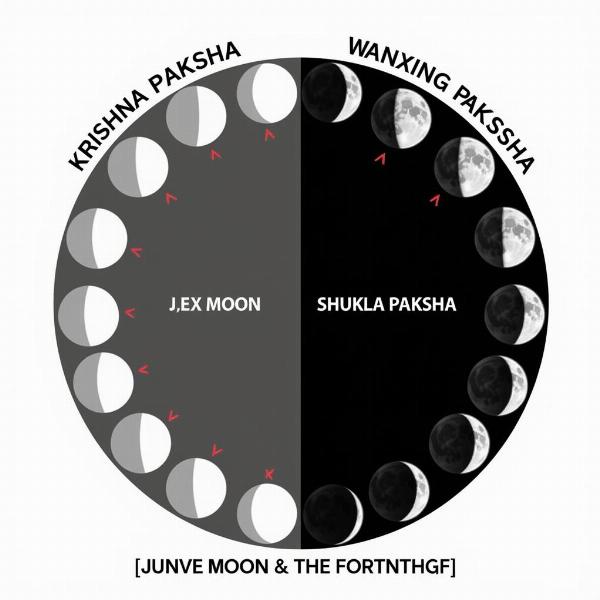The term “pakh meaning in hindi” often arises when exploring Hindu calendars, festivals, and rituals. Understanding “pakh” is crucial for grasping the nuances of timekeeping and cultural practices in India. Pakh, essentially, signifies a lunar fortnight, a period of 15 days within a lunar month. This seemingly simple definition, however, unveils a rich tapestry of cultural and religious significance deeply woven into the fabric of Indian life. Let’s explore the multifaceted layers of “pakh” and its impact on various aspects of Indian culture.
The Two Sides of Pakh: Krishna and Shukla
The lunar month is divided into two pakhs: Krishna Paksha (the waning fortnight) and Shukla Paksha (the waxing fortnight). Krishna Paksha, also known as the dark fortnight, begins with the full moon (Purnima) and ends with the new moon (Amavasya). Conversely, Shukla Paksha, the bright fortnight, commences with the new moon and culminates with the full moon.
 Krishna and Shukla Paksha
Krishna and Shukla Paksha
This cyclical dance of the moon holds immense significance in Hindu cosmology, representing the ebb and flow of energy and the constant cycle of creation and destruction. Each pakh is associated with specific energies and is considered auspicious for different activities.
Auspicious Activities During Each Pakh
Traditionally, Krishna Paksha is considered a time for introspection, rest, and activities related to ancestors. Shukla Paksha, on the other hand, is associated with new beginnings, growth, and auspicious ceremonies like weddings and festivals.
Pakh and Hindu Festivals
Many Hindu festivals are closely tied to the lunar calendar and the specific pakh. For instance, Diwali, the festival of lights, falls on Amavasya, the last day of Krishna Paksha in the Kartik month. Similarly, Holi, the festival of colors, is celebrated on the full moon day (Purnima) of the Phalgun month, marking the end of Shukla Paksha.
Understanding the relationship between pakh and festivals provides a deeper understanding of the symbolism and significance of these celebrations. For example, Diwali’s association with Amavasya, the darkest night, symbolizes the triumph of light over darkness.
Pakh in Daily Life
The concept of pakh extends beyond festivals and permeates various aspects of daily life in India. Traditional calendars often mark the days of each pakh, and many people still consult these calendars for auspicious timings for important events. Farmers also use the lunar calendar and the concept of pakh to guide their agricultural practices.
The Impact of Pakh on Agriculture
Farmers often sow seeds during specific pakshas, believing that the lunar cycle influences crop growth. This practice, passed down through generations, reflects the deep connection between nature and human life in Indian culture.
Pakh: A Measure of Time and Spirituality
Pakh is not merely a unit of time; it’s a reflection of the cyclical nature of life and the universe. It’s a reminder of the constant interplay of opposing forces and the importance of balance. Understanding “pakh meaning in hindi” opens a window into the rich cultural and spiritual heritage of India.
Expert Insights on Pakh
Dr. Anamika Sharma, a renowned scholar of Hindu cosmology, states, “Pakh provides a framework for understanding the rhythmic flow of time in Hindu tradition. It emphasizes the interconnectedness of all things and the cyclical nature of existence.” This resonates with the observation of Pandit Rajesh Mishra, a Vedic astrologer, who adds, “The observance of pakshas allows individuals to align their lives with the natural rhythms of the cosmos, promoting harmony and balance.”
Conclusion: Embracing the Wisdom of Pakh
Understanding “pakh meaning in hindi” provides valuable insights into the intricate tapestry of Indian culture. From festivals to farming, pakh influences various aspects of life, reminding us of the cyclical nature of time and the importance of living in harmony with the cosmos. This ancient system continues to hold relevance in modern India, reflecting the enduring power of tradition and the wisdom embedded within the lunar cycle.
FAQ: Understanding Pakh
- What is the difference between Krishna Paksha and Shukla Paksha? Krishna Paksha is the waning fortnight, starting with the full moon and ending with the new moon. Shukla Paksha is the waxing fortnight, starting with the new moon and ending with the full moon.
- Why are pakshas important in Hindu culture? Pakshas are important because they mark auspicious times for various activities, including festivals, ceremonies, and agricultural practices.
- How many days are there in a pakh? A pakh consists of 15 lunar days.
- Which festivals are celebrated during Krishna Paksha? Diwali is a prominent festival celebrated during Krishna Paksha.
- Which festivals are celebrated during Shukla Paksha? Holi is a major festival celebrated during Shukla Paksha.
- How do farmers use the concept of pakh? Farmers use the lunar calendar and the concept of pakh to determine auspicious times for sowing seeds and other agricultural activities.
- What is the spiritual significance of pakh? Pakh symbolizes the cyclical nature of life and the universe, reminding us of the constant interplay of opposing forces and the importance of balance.
Meaning-Hindi.in is your trusted partner for accurate and culturally sensitive Hindi translations. We specialize in a wide range of translation services, including business and commercial documents, legal and certified translations, technical manuals, website localization, educational and academic materials, and express translation services. We understand the nuances of the Hindi language and culture, ensuring that your message is conveyed effectively and respectfully. Need a reliable Hindi translation? Contact us at [email protected] or call us at +91 11-4502-7584. Meaning-Hindi.in is here to bridge the language gap for you.